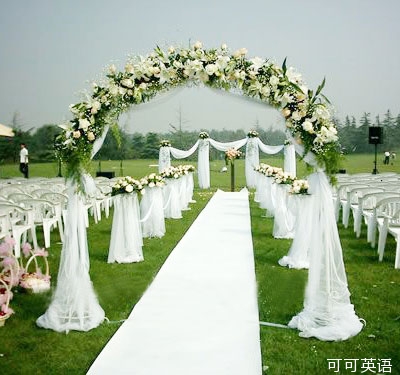
Armenia:
亞美尼亞:
Two white doves may be released to signify love and happiness.The bride may dress in red silk and may wear cardboard wings with feathers on her head.Small coins may be thrown at her.
人們放飛兩只白鴿,以示愛情和幸福。新娘穿著紅色絲質服裝,頭戴飾有羽毛的紙翼。人們還可向新娘投擲硬幣。
Caribbean:
加勒比地區:
A rich black cake baked with dried fruits and rum is especially popular on the islands of Barbados, Grenada and St.Lucia.
在巴巴多斯,格林納達和圣盧西亞,用干果和朗姆酒制作的味道濃郁的蛋糕十分常見。
It is considered a“pound”cake — with the recipe calling for a pound each of flour, dark brown sugar, butter, glace cherries, raisins, prunes, currants, plus a dozen eggs and flavorings.
人們把這種蛋糕稱為“一磅”蛋糕,因為制作這種蛋糕需要面粉、紅糖、黃油、糖霜櫻桃、葡萄干、李子、紅醋栗各一磅,加上一打雞蛋和調味品。
The dried fruits are soaked in rum and kept in a crock anywhere from two weeks to six months.
制作蛋糕的干果要在朗姆酒中浸泡并在瓦罐中保存兩個星期至6個月。
Croatia:
克羅地亞:
Married female relatives remove the bride’s veil and replace it with a kerchief and apron, symbols of her new married status.
由已婚的女性親戚摘下新娘的面紗,換成一塊頭巾和一條圍裙,意味著新娘的已婚身份。然后由所有的已婚婦女為新娘唱小夜曲。
She is then serenaded by all the married women.Following the wedding ceremony, those assembled walk three times around the well (symbolizing the Holy Trinity) and throw apples into it (symbolizing fertility).
婚禮儀式結束之后,所有來賓圍繞著井走三圈(象征著圣父、圣子、圣靈三位一體),并向井中扔蘋果(象征著生育)。
The Czech Republic:
捷克共和國:
Friends would sneak into the bride’s yard to plant a tree, then decorate it with ribbons and painted eggshells.
朋友們溜進新娘的院子去種一棵樹,然后再用彩帶和彩繪的蛋殼將樹加以裝飾。
Legend said she would live as long as the tree.Brides in the countryside carry on the very old custom of wearing a wreath of rosemary, which symbolizes remembrance.
傳說新娘將與這棵樹活得一樣長。鄉村的新娘還保留著佩帶迷迭香花環的傳統習俗,以表懷念之情。
The wreath is woven for each bride on her wedding eve by her friends as a wish for wisdom, love, and loyalty.
花環是在婚禮前夕由新娘的朋友編織而成,它象征著智慧、愛情和忠誠。
Egypt:
埃及:
Families, rather than grooms, propose to the bride.In Egypt, many marriages are arranged.The zaffa, or wedding march, is a musical procession of drums, bagpipes, horns, belly dancers, and men carrying flaming swords; it announces that the marriage is about to begin.
在埃及,由新郎的家人,而不是新郎本人,向新娘求婚。許多婚姻還是父母之命,媒妁之言。Zaffa,也就是婚禮,其實是一個有音樂伴奏的列隊游行,有鼓、風笛、號角及肚皮舞,男人們手持火紅的劍。這個儀式宣告婚姻即將開始。
England:
英格蘭:
Traditionally, the village bride and her wedding party always walk together to the church.Leading the procession: a small girl strewing, blossoms along the road, so the bride’s path through life will always be happy and laden with flowers.
按照傳統,鄉村的新娘和參加婚禮的人們總是一起走向教堂。一個小姑娘走在隊列的最前面,她一路拋撒鮮花,預示著新娘的一生幸福快樂,鮮花永伴。
Finland:
芬蘭:
Brides wear golden crowns.
新娘頭戴金色的花冠。
After the wedding, unmarried women dance in a circle around the blindfolded bride, waiting for her to place her crown on someone’s head.
婚禮后,未婚女子圍著被蒙住眼睛的新娘跳舞,等著新娘將花冠戴到某個人的頭上。
It is thought that whoever she crowns will be the next to wed.The bride and groom have seats of honor at the reception.
被新娘戴上花冠的人被認為是下一個要結婚的人。新娘和新郎坐在婚宴的貴賓席上,新娘手持一個篩子,篩子上蓋有一塊絲綢披巾。
The bride holds a sieve covered with a silk shawl.when the guests slip money into the sieve, their names and the amounts given are announced to those assembled by a groomsman.
當來賓們將錢塞進篩子時,一個伴郎會向在場的來賓宣布放錢的來賓姓名以及禮金的數額。
Greece:
希臘:
The koumbaros, traditionally the groom’s godfather, is an honored guest who participates in the wedding ceremony.
按照傳統是由新郎的教父來擔任婚禮的嘉賓。
Today, the koumbaros is very often the best man, who assists in the crowning of the couple (with white or gold crown, or with crowns made of everlasting flowers, or of twigs of love and vine wrapped in silver and gold paper), and in the circling of the altar three times.
現在,嘉賓通常由伴郎擔任,其職責是協助新郎新娘戴上花冠(花冠有白色和金色的,花冠由四季開放的鮮花,或由用金色或銀色的紙包起來的象征愛情的樹枝和藤編織而成)。戴上花冠后,新人們圍著圣壇繞三圈。
Other attendants may read Scripture, hold candles, pack the crowns in a special box after the ceremony.To be sure of a“sweet life”, a Greek bride may carry a lump of sugar in her glove on wedding day.
其他出席婚禮的賓客則手持蠟燭,朗讀《圣經》,并在婚禮后將花冠放置在一個特殊的盒子里。為了婚后生活能甜蜜,希臘新娘在結婚那一天,可在手套里塞一塊糖。











